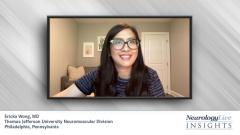
Gaps in Care in Myasthenia Gravis and Take-Home Points
Ericka Wong, MD, comments on gaps in care in myasthenia gravis and provides take-home messages for physicians treating patients with this condition.
Episodes in this series

Ericka Wong, MD: In terms of gaps that remain in the care of patients with myasthenia gravis, certain populations, particularly zero-negative patients, as well as patients with MuSK [muscle-specific tyrosine kinase] myasthenia, I think it remains difficult to know what treatment is best for them. In many of these trials, the majority of patients were acetylcholine receptor antibody positive. I think for that population, we need more data to see what medications would be efficacious for them. In terms of how they might be addressed in the future, certainly because of its mechanism, efgartigimod, the neonatal Fc receptors, they may be possibly effective in this population of patients. We’ll see with the ongoing open-label extension trials, as well as the new agents that are coming out, if these medications might be efficacious in these patients.
For my patients with myasthenia gravis, I think the take-home message is that you individualize treatment to the patient and what their goals are, as well as us considering their comorbidities. I often told patients before that treating myasthenia is a marathon. It takes time to get them to where they want to be; it’s not a sprint. Certainly, with these new agents, it may not be as long of a marathon as it was before. I think that’s promising for the treatment of our patients in the future.
Thank you for watching today, I hope you found it helpful. There’s more to come regarding the new medications for myasthenia gravis.
Transcript Edited for Clarity
Newsletter
Keep your finger on the pulse of neurology—subscribe to NeurologyLive for expert interviews, new data, and breakthrough treatment updates.
















